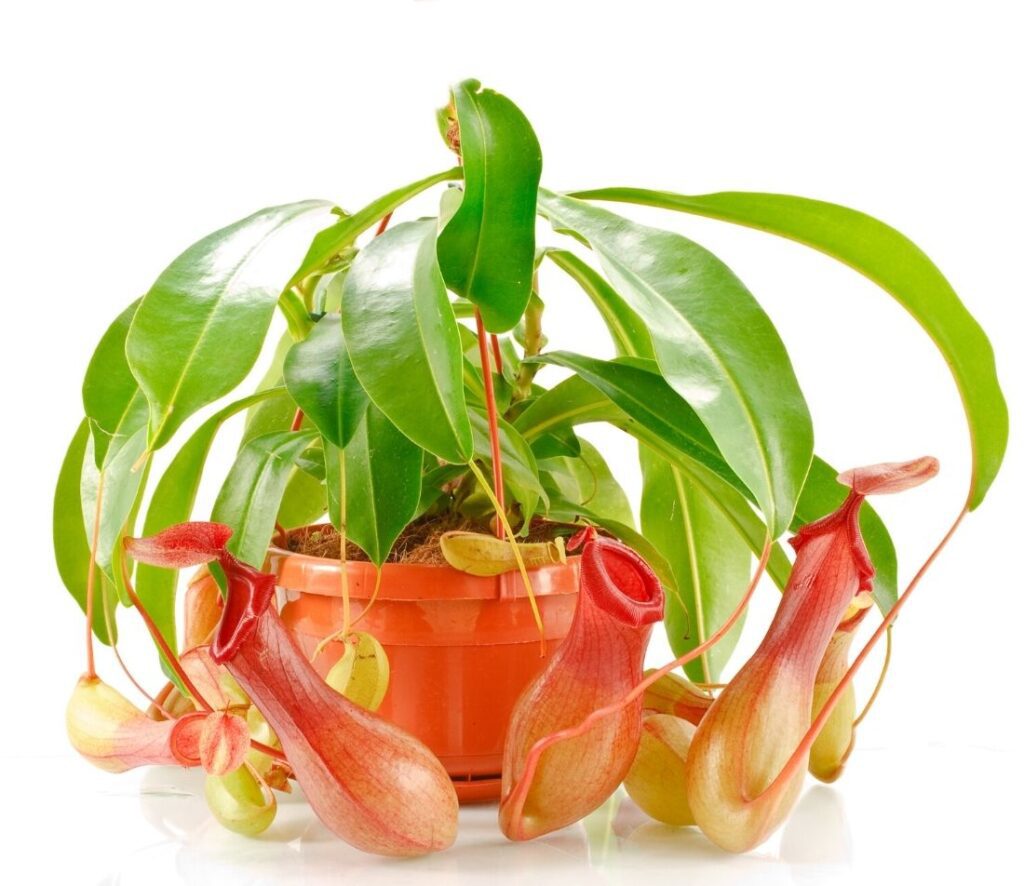The pitcher plant (Nepenthes hybrids) belongs to the carnivorous plants, called insectivores or carnivores.
It cleverly forms its leaves into bulbous traps from which there is no escape for small insects once they have fallen in. So the plant only has to wait to catch the insects.
The pitcher plant looks very good in a hanging basket.
Contents
Growth and appearance of the pitcher plant
The pitcher plant is the only genus to belong to the pitcher shrub family (Nepenthaceae). Of course, the more than 100 known species occur in Southeast Asia, for example in Malaysia, Sumatra, Borneo, Australia, the Philippines and Madagascar. In the hot tropical jungle, the plants climb as lianas up to a height of 15 metres.
The pure botanical species of the pitcher plant are only available in specialist nurseries, but the more robust hybrids can also be found in regular garden shops such as garden centres. They are available in different sizes, as a hanging plant or as a pot plant, and grow 15 to 20 centimetres high. The pitcher plant forms shallow roots that are rather delicate.
Leaves of the pitcher plant
The pitcher plant has leaves of different shapes. The green, thick-fleshed leaves with a lanceolate shape are divided by a strong midrib that merges into a thick leaf tendril. At the end of the tendril are the pitchers, which are more or less transformed leaf blades. The pitchers can be different colours: greenish, yellow, reddish brown or even speckled. In addition, the shape can vary: There are ground pitchers that go after crawling insects – they have a roundish shape. Air pitchers are tubular in shape and aimed at flying insects.
In their natural location, the pitchers are always one-third full of water. An immovable “lid” prevents it from raining in. This also has fragrant glands that attract the insects. The “victims” then slide over a smooth sliding zone into the interior, where they are digested by the water enriched with poisonous secretions. Flowers and fruits do not usually form on this carnivorous plant in indoor culture.

Site conditions
The pitcher plant needs a very bright and warm place at above 20 degrees Celsius all year round. East or west windows, for example, are well suited. In addition to plenty of light, very high humidity is also absolutely essential. Ideally, the pitcher plant should be kept in a converted flower window or in a warm, humid greenhouse. Indoors, planting in a terrarium or glass display case is a good way to create the ideal climate.
Use an airy orchid substrate, peat or a special carnivore substrate for planting, fertiliser as well as additives should not be included. Be careful not to damage the delicate roots when transplanting. The best time for repotting is during the growth phase in summer.
Care of the pitcher plant
Water the pitcher plant sufficiently in summer and use only softened, room-warm water, for example rainwater. The substrate should never dry out, but waterlogging should be avoided. It is best to supply the pitcher plant with water via a saucer and not water directly onto the substrate. Also check that there is enough liquid in the pots, about one to two centimetres high.
Ensure high humidity by spraying the pitcher plant frequently. To do this, also use only room-warm, low-lime water. If you do not have rainwater available, let the water stand for several hours, preferably overnight, before watering.
The pitcher plant does not need to be fertilised, as it supplies itself with the necessary nutrients through the digested insects as well as through its leaves and the substrate itself.
Use of the pitcher plant
The pitcher plant looks very good in a hanging basket or a tall container. Then it lets its conspicuous traps hang down quite decoratively. However, it is important to ensure that the carnivorous plant is sufficiently humid by spraying it. A place in the flower window, in a warm and humid greenhouse or in a terrarium is ideal.


